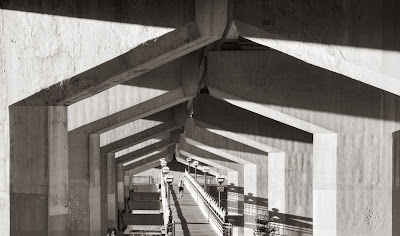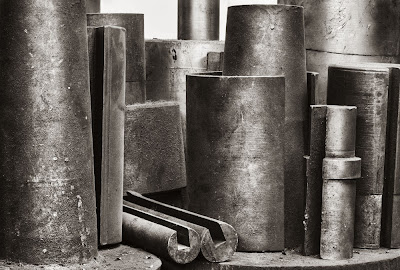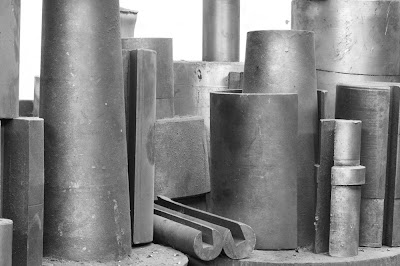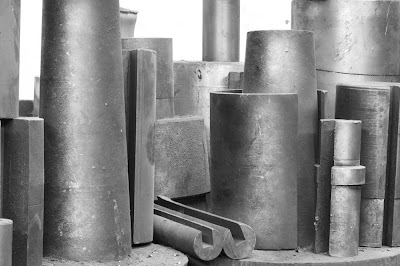There are lots of discussions, books, articles and even some of my own blog entries discussing how to manipulate an image once recorded. I thought I'd discuss today more the matter of why, after all, knowing how to saw a board isn't enough to build a house.
Before even getting to the point of manipulating the image, perhaps it's only fair to discuss how far it's legitimate to go. As you know from some of my images, I'm prepared to go fairly far in working on an image (the recent machine shop cylinders images are proof of that). Not everyone feels that they want to alter the original scene. Some are in fact obsessed with keeping the scene as true to the original as possible and eschew any manipulation at all. I have addressed this issue before as have others so I won't debate that issue. Rather, lets start by looking at manipulation done to modify the recorded image to match the experience the photographer had at the time.
Unless the photographer was on LSD at the time, we can make some basic assumptions. First is that the photographers eye is much better able to cope with a range of brightnesses than any camera and more than likely we are going to have to compensate for that fact. Second, the human eye adapts to strong colour shifts within seconds meaning that strong colour casts rendered by lighting a scene only with a deep blue sky won't be seen by the photographer and if left in the image, will look unreal. Third, the photographer saw the scene in three dimensions (unless he squinted) and things that separate out nicely on scene may look jumbled in the print. Likewise the eye looks at part of the scene at a time, placing much less emphasis on the whole scene, exactly the opposite of the camera and that too may affect the appearance of the print.
With these problems in mind, the question then is what to do about it.
1) contrast range - without getting into a discussion of HDR (see
Outback Photo for discussions on HDR), if we assume that the camera managed to record the dynamic range of the scene, the question now is whether it portrayed that range in the same way the eye saw the scene. The answer is almost certainly not.
Whether HDR was used or not, the contrast and brightness are almost certainly going to need adjustment at a local level to make the scene look more realistic. When the eye saw the shadows, they had lots of contrast. Flattening overall contrast through HDR or through settings in camera raw or through an overall curve adjustment to the whole image results in parts of the image looking too flat. We need to restore contrast in those areas without affecting the others.
Put simply, first we lower contrast to contain the dynamic range, then we pump up the contrast back to normal within parts of the image to get closer to what the eye saw.
2) Colour balance - it may be convenient to use the colour balance determined in camera but really, that's at best a guestimate of what the scene should have looked like. Just as a light meter assumes that the scene is going to average out to middle gray, the white balance assumes a normal blend of colours and that any lean towards one colour is from the light source, not the subject. Of course, this may not be true. A white balance of green leaves with more green in the background is going to assume the green comes from the light source and will alter the leaf colour - which you may not want. When I was photographing Jura Canyon, my eye saw the rocks as subtly blue gray. The camera recorded the scene as brilliantly blue and adjusted accordingly. It took some work with Camera Raw to return the tonalities to close to memory. As you adjust the contrast you are also going to change the colour saturation so work will have to be done here too. It's more than likely that some parts of the scene will need more work than others.
Local colour adjustment may be necessary to remove tints the eye manages to ignore - the green of a wall which is next to a tree in leaf or the red in a white sweater next to someone's red jacket.The eye knows it's white and ignores the pink on that side - the camera doesn't and in a print the eye doesn't seem to have the same ability to ignore the pink.
3.Separatng the Sub-Scenes
It's not just a matter of separating parts of the image, it's more a matter of emphasizing that which is important while downplaying the bits between. The eye can do this as it moves around a scene but has more trouble doing so within the boundaries of a relatively small print - so we are going to give it some help. We can do this in a number of ways - lower contrast for the leafy background, or darkening the area between rocks or players, while increasing contrast or lightening the important parts. In the 'olden' days of the wet darkroom, we routinely added a bit of print exposure in the edges and corners to compensate for light falloff in the enlarger. Truth though is that we generally took this a bit past compensating to help keep our focus within the print.
Some photographers take this darkening way over the top, especially in the sky. It's one thing for it to show as part of the unique optics of a Holga, but sometimes it looks quite ridiculous - even in published work. That said, subtle adjustments can be useful.
Remember that here we're talking about making an image look like the way you remember it, any adjustments shouldn't look like they were done well, they shouldn't be seen at all.


































